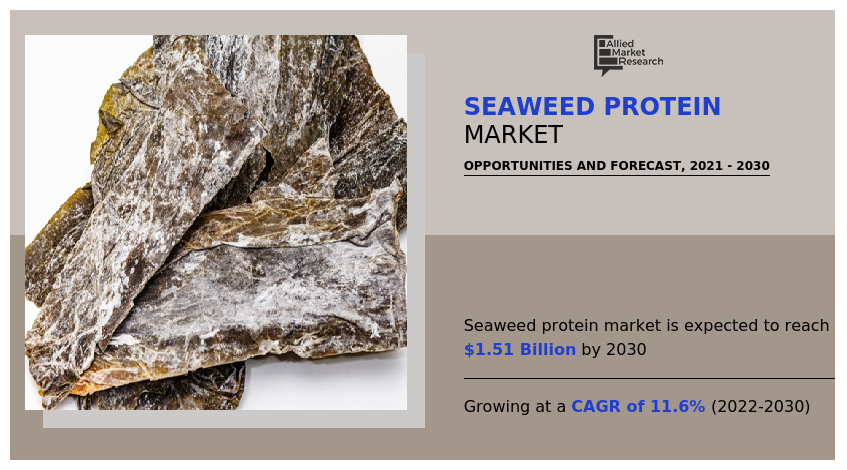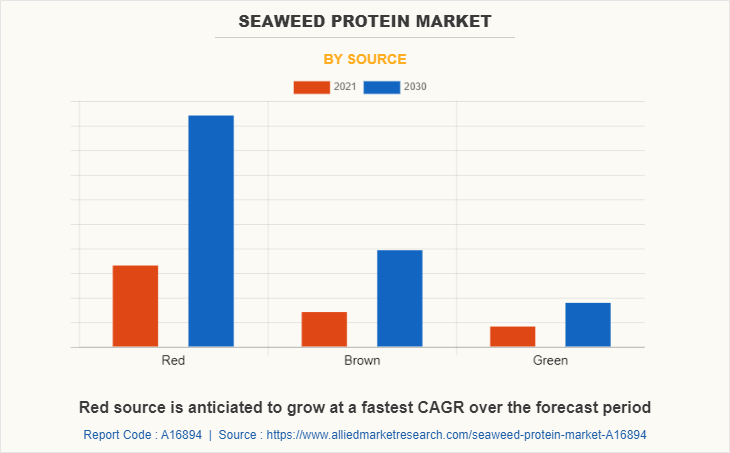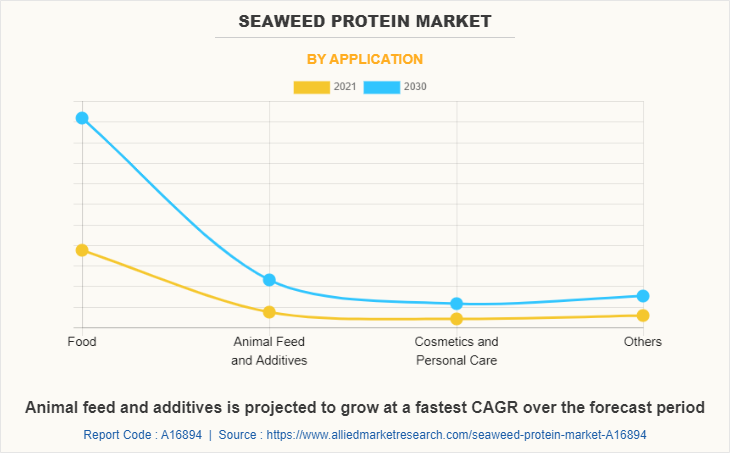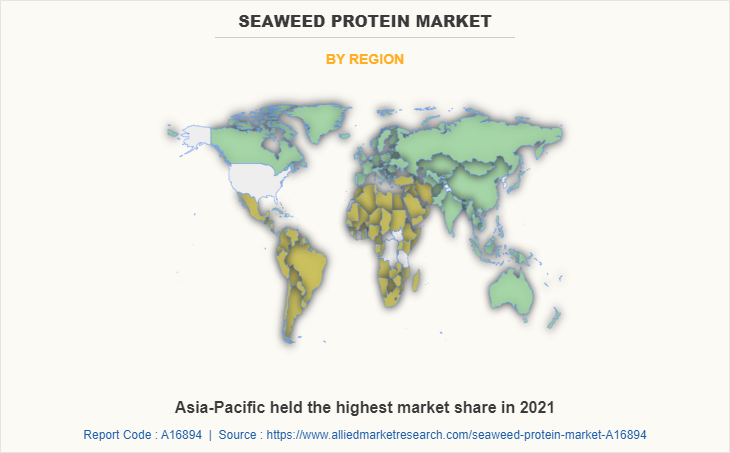Seaweed Protein Market Research, 2030
The global seaweed protein industry was valued at $550.40 million in 2021, and is projected to reach $1.51 billion by 2030, growing at a CAGR of 11.6% from 2022 to 2030. The global seaweed protein market size is increasing, owing to rising demand for plant-based foods. Seaweeds are healthy as they are rich in minerals, vitamins, and micronutrients, all of which aid in the promotion of good health. As a result, the global seaweed protein demand is estimated to increase during the forecast period. The need for healthy plant-based products is majorly driving the global expansion of plant-based protein supplements and is anticipated to drive the seaweed protein market growth.

Seaweed farming is considerably expensive than land farming, which could hamper the global seaweed protein market revenue growth. Furthermore, due to presence of harmful minerals, excessive consumption of seaweed might create health concerns. Most of the seaweed contains high levels of iodine that may affect the human body, if consumed excessive seaweed products over an extended period. People can suffer due to high levels of iodine as some are more vulnerable to its effects, which can include hyperthyroidism. This condition may cause drastic weight change or swelling and tightness around the neck.
Popularity of seaweed protein as a plant-based protein in food products is rising as it has a number of benefits. Seaweed protein is rich in nutrients which is anticipated to generate excellent opportunities for the key players operating in the market. Seaweed farming's high expenses, on the other hand, are expected to hamper the market revenue growth. Seaweed output has increased year after year as customers seek a better lifestyle, resulting in higher demand for seaweeds. Seaweeds are pure, safe, secure, high-quality, and nutritious based. the aforementioned factors are anticipated to propel the market over the forecast period.
Some of the leading market players are CP Kelco, Cargill, Incorporated, Qingdao Gather Great Ocean Algae Industry Group CO. LTD, Mara Seaweed, ASL, Irish Seaweeds, AtSeaNova, ALGAIA, Seasol, and Maine Coast Sea Vegetables.
The seaweed protein market is segmented on the basis of type, application, and region. By type, the market is sub-segmented into red, brown, and green. By application, the market is classified into food, animal feed & additives, cosmetics & personal care, and others. By region, the market is analyzed across North America, Europe, Asia-Pacific, and LAMEA.
The seaweed protein market is segmented into Source and Application.

By type, the red sub-segment dominated the market in 2021. Red seaweed has the highest protein content. Also, red seaweed has higher level of minerals, vitamins, trace elements, and essential fatty acids. Red seaweed is commonly used as a raw ingredient in Asian cuisines, salads, and soups. Furthermore, in nations such as Korea, the U.K., and Japan, several well-known red seaweeds with high nutritional content, such as gim seaweed, dulse seaweed, and nori/porphyra seaweed, are commonly consumed.

By application, the food sub-segment dominated the market 2021. This increase in the market can be attributed to the use of seaweed in the food industry, as red and brown seaweeds can be used to make three different types of hydrocolloids, which are non-crystalline substances that thicken (viscous) solutions when dissolved in water, such as carrageenan, agar, and alginate. Hydrocolloids are primarily utilized in the food industry to emulsify, gel, preserve, and thicken foods and beverages. All of these factors are projected to drive the seaweed protein market share in food applications and accelerate market expansion.

By region, North America is projected to remain the fastest-growing sub-segment during the forecast period. Plant-based products are in high demand in the North America region. The U.S. has a monopoly in the seaweed market in the region. The market for seaweed protein in North America is predicted to grow at a CAGR of 12.9%, creating $432.4 million in sales. Seaweeds are rich in minerals, vitamins, and micronutrients, all of which contribute to good health which is attracting the U.S. population. In addition, major players are seeking for strategic alliances and collaborations to help them increase their product reach in the global market. In April 2020, Acadian, a Canadian food supply chain company, announced that its seaweed extract products can help farmers boost plant productivity. As a result of these factors, the demand for seaweed protein is expected to rise in the next years.
Impact of COVID-19 on the Global Seaweed Protein Market
- COVID-19 has negatively impacted various industries such as farming that has led to a drastic decline in availability of food products. As seaweed is widely used in the food industry, there was significant reduction in the seaweed demand globally.
- North America is the leading producer and exporter of seaweed food products as they are rich in minerals, vitamins, and micronutrients. However, as North America was severely impacted due to the COVID-19 pandemic, its export trade was affected, leading to a decline in seaweed production.
- In February2022, seaweed farming formed a major livelihood activity of the fisherfolk community of the Ramanathapuram district of India where seaweed farming is done on a commercial scale. The COVID-19 pandemic restrictions and lockdown across the globe severely affected the farming activities and the supply chain was disrupted.
Key Benefits For Stakeholders
- This report provides a quantitative analysis of the market segments, current trends, estimations, and dynamics of the seaweed protein market analysis from 2021 to 2030 to identify the prevailing seaweed protein market opportunities.
- The market research is offered along with information related to key drivers, restraints, and opportunities.
- Porter's five forces analysis highlights the potency of buyers and suppliers to enable stakeholders make profit-oriented business decisions and strengthen their supplier-buyer network.
- In-depth analysis of the seaweed protein market segmentation assists to determine the prevailing market opportunities.
- Major countries in each region are mapped according to their revenue contribution to the global seaweed protein market forecast.
- Market player positioning facilitates benchmarking and provides a clear understanding of the present position of the market players.
- The report includes the analysis of the regional as well as global seaweed protein market trends, key players, market segments, application areas, and market growth strategies.
Seaweed Protein Market Report Highlights
| Aspects | Details |
| By Source |
|
| By Application |
|
| By Region |
|
| Key Market Players | seasol international pty ltd, cargill, cp kelco, Mara Seaweed, algaia, Qingdao Gather Great Ocean Algae Industry Group Co Ltd, Maine Coast Sea Vegetables, Atseanova, acadian seaplants, Irish Seaweed |
Analyst Review
Seaweed protein is used in animal feed because of the nutritional and biological benefits it provides to cattle. It is used in development of aquaculture feed, monogastric cattle feed, ruminant feed, and others. Cattle's overall health and growth rate is improved due to consumption of seaweed protein. Expansion of this market is fueled owing to rising meat consumption, increased livestock industrialization, and increased need for nutritious feed. Seaweed farming is more expensive than land farming, which is a significant factor that is predicted to hamper the market. Additionally, due to presence of harmful minerals, excessive consumption of seaweed might result in health issues. As a result, the market revenue growth over the projection period may be negatively impacted by all of these factors. Plant-based proteins are becoming more popular among consumers as they are shifting their preference from animal proteins, owing to demand for plant protein ingredients is rising quickly. The market for seaweed protein is expected to grow as a result of a change in consumer preferences for supplements made from plants. Under Pradhan Mantri Matsya Sampada Yojana (PMMSY), the Government of India decided to produce fresh sea weed of 11.2 lakh MT by 2025.
Among the analyzed regions, North America is expected to account for the fastest growing CAGR in the market by the end of 2030, followed by Europe, Asia-Pacific, and LAMEA. In North America, consumption of natural ingredients is trending and seaweeds is being considered as they are rich in minerals, vitamins, and micronutrients, which helps in promoting good health.
The global seaweed protein industry is witnessing a massive growth mainly due to increasing popularity of plant-based products. Increasing the use of seaweed protein in nutraceuticals will create massive investment opportunities for the key players in the global seaweed protein market.
The use of seaweed protein in diet, in animal feed and additives, in cosmetics and personal care products, and others is estimated to drive the adoption of seaweed protein.
Asia-Pacific will provide more business opportunities for global seaweed protein market in future.
Some of the leading seaweed protein market players are CP Kelco, Cargill, Incorporated, Qingdao Gather Great Ocean Algae Industry Group CO. LTD, Mara Seaweed, ASL, Irish Seaweeds, AtSeaNova, ALGAIA, Seasol, and Maine Coast Sea Vegetables.
Strategic alliances among market players, along with rising health benefits associated with seaweed, is expected to accelerate growth of the seaweed protein market.
The report provides an extensive qualitative and quantitative analysis of the current trends and future estimations of the global seaweed protein market from 2021-2030, to determine the prevailing opportunities.
Loading Table Of Content...


